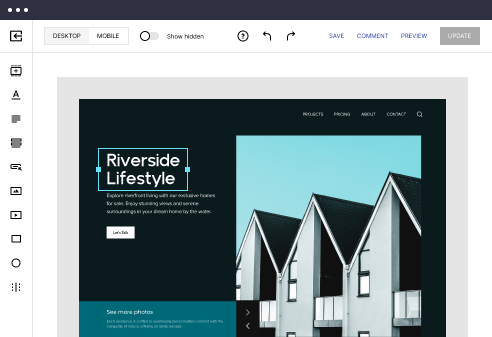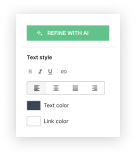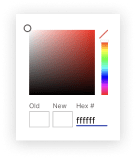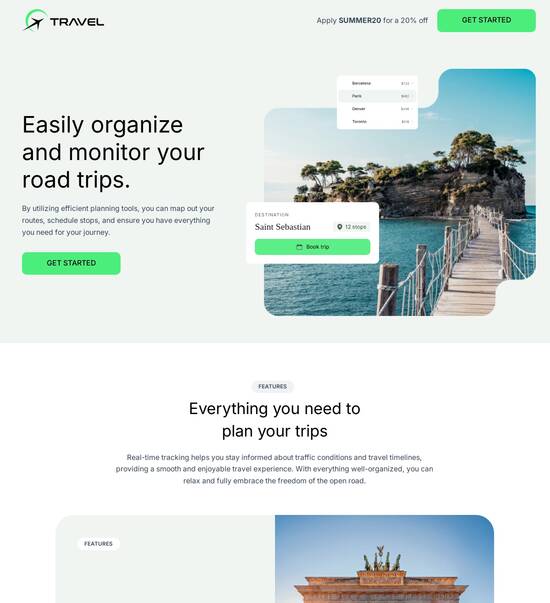
HTML/CSS optimized wishlist page template
Explore Similar TemplatesAbout template
Supercharge your wishlist page with HTML/CSS for outstanding performance! Learn more today.
Recommended templates
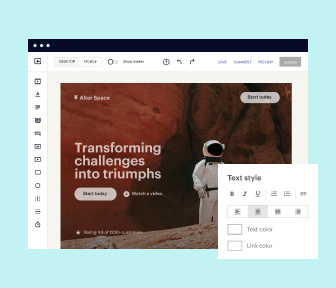
Easy to build without coding
With the intuitive drag-and-drop builder, anyone on your team can create high-converting pages without any knowledge of code or design. Make enhancements to your landing page with custom widgets using Javascript, HTML/CSS, or third-party scripts.
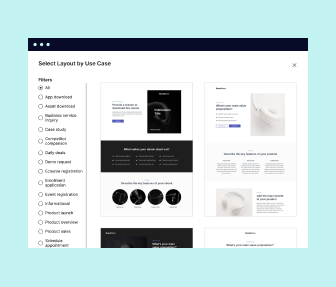
Multiple layouts for any industry and goal
Select from 500+ landing page layouts built to boost conversions across industry-specific scenarios. Customize them by adjusting fonts, adding images, and generating on-brand content with the AI assistant. Quickly scale with Instablocks® and Global Blocks that you can save, reuse, and update globally.
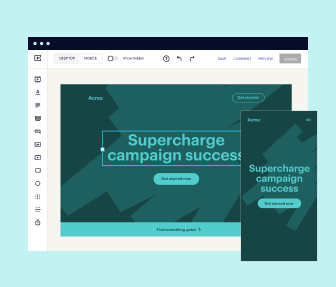
Loads fast and looks polished on any device
Every template is responsive, which means they present professionally on any device and load blazingly fast with our Thor Render Engine. You can also power them up with Google AMP technology to deliver an unparalleled mobile experience and drive higher conversions.
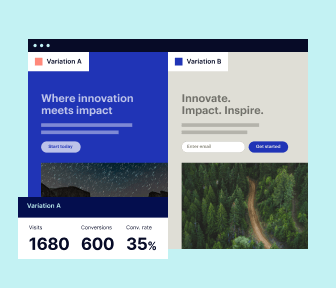
Robust analytics & experimentation
Get real-time updates and reporting across all your devices, showing the number of visitors, conversions, cost-per-visitor, and cost-per-lead. Launch AI-powered experiments, run A/B tests, and use heatmaps to analyze user behavior, then optimize your landing page to maximize conversions.

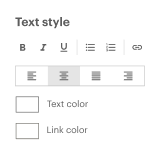
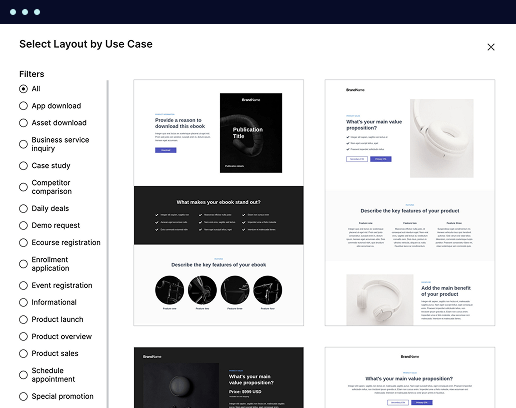
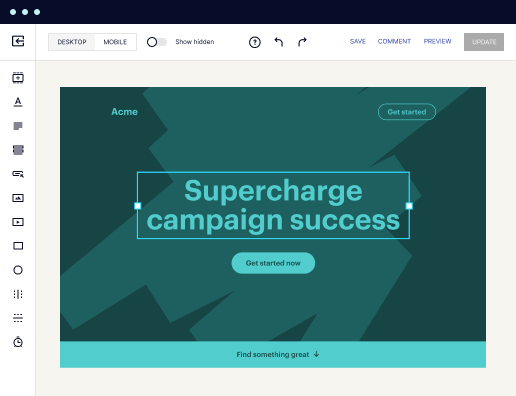
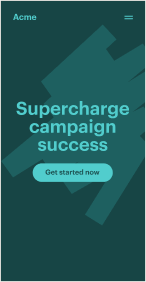
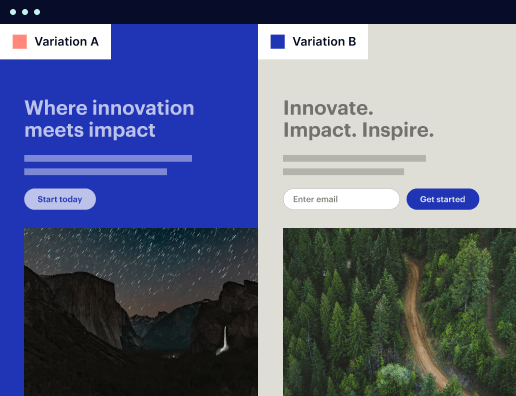

Easy to build without coding
With the intuitive drag-and-drop builder, anyone on your team can create high-converting pages without any knowledge of code or design. Make enhancements to your landing page with custom widgets using Javascript, HTML/CSS, or third-party scripts.
Multiple layouts for any industry and goal
Select from 500+ landing page layouts built to boost conversions across industry-specific scenarios. Customize them by adjusting fonts, adding images, and generating on-brand content with the AI assistant. Quickly scale with Instablocks® and Global Blocks that you can save, reuse, and update globally.
Loads fast and looks polished on any device
Every template is responsive, which means they present professionally on any device and load blazingly fast with our Thor Render Engine.
Robust analytics & experimentation
Get real-time updates and reporting across all your devices, showing the number of visitors, conversions, cost-per-visitor, and cost-per-lead. Launch AI-powered experiments, run A/B tests, and use heatmaps to analyze user behavior, then optimize your landing page to maximize conversions.
All the features you need to build wishlist page design in html
Explore more featuresLearn how to build wishlist design
Frequently asked questions about wishlist page template
Leading the way in building high-performing landing pages





Wishlist html css: Your ultimate how-to guide
Creating effective landing pages is crucial for maximizing ROI in digital marketing. Instapage stands out as a premier solution, offering tools and resources that simplify the process of launching high-converting landing pages. This guide will walk you through the steps to leverage Instapage for your marketing campaigns, ensuring that you optimize your efforts and enhance audience engagement.
Understanding Instapage's advantages for marketers
Instapage provides a unified platform enabling marketers to build, optimize, and customize landing pages swiftly without coding knowledge. Its extensive library of over 100 templates paired with advanced personalization features allows you to tailor experiences for different segments of your audience. The built-in analytics tools help track performance, ensuring your campaigns are always data-driven.
- Ease of use: Instapage's intuitive interface allows rapid page creation.
- High-converting templates: Ready-to-use designs that have been tested for success.
- Analytics dashboard: Real-time insights into page performance for continuous improvement.
Step 1: Creating your landing page using Instapage
To begin, follow these steps to create a landing page tailored to your specific campaign goals:
- Choose a template: Select from the library of conversion-focused layouts.
- Customize your content: Use the drag-and-drop builder to edit text, images, and forms.
- Integrate lead generation tools: Add elements like email capture forms or CTAs to drive conversions.
Step 2: Optimizing your page for better conversions
After your page is created, the next step is optimization. Consider the following approaches:
- Utilize A/B testing: Experiment with different headlines or layouts to see what resonates most.
- Analyze user behavior: Use heatmaps to understand how visitors interact with your page.
- Refine based on data: Implement changes based on insights gained from analytics.
Step 3: Engaging your audience with personalized content
Personalization can significantly enhance user experience. Incorporate these strategies:
- Dynamic text replacement: Tailor messages in real-time based on user data.
- AdMaps: Align specific ads with corresponding landing pages for a cohesive experience.
- Audience tracking: Use data tools to understand different audience segments better.
By following these steps, marketers can leverage Instapage to effectively drive campaign success through optimized landing pages.
Ready to boost your marketing efforts? Start using Instapage today and transform your landing pages into powerful tools for conversion!
People also ask about wishlist page design
HTML/CSS optimized wishlist page template
Understanding the purpose of a wishlist page in e-commerce
A wishlist page is an essential feature in e-commerce platforms that allows users to save items they are interested in purchasing at a later time. This functionality offers significant advantages both for shoppers and retailers alike. Users can create a list of products that catch their eye without committing to a purchase immediately, offering them the flexibility to revisit their choices later.
The importance of wishlist functionality cannot be overstated. Firstly, it enhances user engagement as customers interact more with the site, spending additional time browsing items. Secondly, it encourages return visits, as customers often return to their lists, likely leading to conversion. Lastly, wishlist features can significantly boost conversion rates by easing the decision-making process for shoppers who may be deliberating between products.
Platforms like fashion retailers, electronics stores, and home goods markets typically incorporate wishlist pages to maximize customer satisfaction and drive sales. These sites leverage wishlist functionality to track user interest patterns and better strategize marketing efforts towards their audience.
Key features of an optimized wishlist page template
An optimized wishlist page template is not just about containing a list of items; it’s about creating a visually appealing and user-centric experience. Key design elements include intuitive navigation and layout that guide users effortlessly through their choices. An engaging visual appeal, enhanced with graphics and GIFs, can help to showcase items attractively.
Furthermore, responsive design considerations are vital for accessibility across various devices. An increasing number of consumers shop via mobile devices, making it essential that wishlist pages look and function well regardless of the screen size. Mobile-friendly implementations make it easy for users to manage their wishlists on the go.
Customization options within themes also play a critical role. Retailers have the opportunity to tailor the wishlist experience to capture their brand identity effectively. Unique UI elements must reflect the store’s aesthetics, ensuring a seamless blend with the overall user experience.
Lastly, performance optimization should never be ignored. Fast loading times are crucial, as minimal wait time directly impacts user satisfaction. Implementing backend file optimization strategies can help ensure that wishlist functionality remains efficient and user-friendly.
Technical implementation of a wishlist page template
Creating a wishlist page involves certain required code components, starting with the essential HTML structure that forms the backbone of the page. It should include elements like product images, descriptions, and buttons to add or remove items. These elements need to be arranged logically to foster a seamless user experience.
After establishing the HTML template, CSS styles should be incorporated to enhance both usability and visual appeal. These styles can provide a unique aesthetic, ensuring that colors, fonts, and spacing reflect the brand’s identity. Attention should also be paid to user-friendly design aspects such as button sizes and hover states.
JavaScript functions are also required to manage wishlist interactions, including functionality to add, remove, and edit items quickly. Setting up this code will allow for real-time updates and improved responsiveness. Lastly, linking the wishlist with user accounts and sessions is essential for retailers to track individual user preferences.
Setting up the basic HTML structure
Crafting the CSS styles for optimal visual presentation
Writing JavaScript code to handle functions (add, remove, edit items)
Linking the wishlist with user accounts and sessions
Enhancing user experience with dynamic features
Dynamic features enrich the user experience on a wishlist page by incorporating interactive elements that help capture shoppers’ attention. This can include animations and transitions in the user interface created using CSS, which can offer responsive eye-catching engagement. These simple yet effective visual tutorials can guide users on how to interact with their wishlist effectively.
Moreover, integrating GIFs to showcase products can foster an immersive experience for shoppers, allowing them to visualize items in action. Combining attractive visual elements enhances the overall page aesthetic while simultaneously keeping shoppers engaged.
Incorporating social sharing options plays a vital role in expanding the reach of your wishlist feature. Customers should be encouraged to share their lists on social media platforms, which not only promotes user engagement with friends but also increases visibility and brand awareness. Furthermore, implementing notifications and alerts can help maintain user interest by providing real-time updates when wishlist items go on sale, or sending email notifications as reminders.
Best practices for wishlist page management
Effective management of wishlist pages requires techniques for monitoring wishlist activity. Retailers can utilize analytics to assess performance, understanding how often products are added or removed from wishlists. Such data can inform not only marketing tactics but also product inventory considerations, helping to produce a more user-oriented experience.
Integrating wishlists with broader e-commerce functionality is also advisable. By syncing wishlist items with inventory management systems, retailers can prevent frustration caused by items going out of stock, leading to better purchase fulfillment. Analyzing wishlist data can also reveal opportunities for cross-selling, displaying related products that are likely to appeal to users based on their saved items.
Case studies: Successful implementations of wishlist pages
Examining successful examples provides insight into effective wishlist page implementations. Case Study One features a luxury retail brand that enhanced their wishlist functionalities with personalized user recommendations, visually stunning layouts, and social sharing integrations. These features significantly increased user engagement, resulting in higher conversion rates by allowing users to easily add desired items to their carts.
Conversely, Case Study Two highlights a budget-friendly e-commerce platform that creatively appealed to price-sensitive shoppers. Strategies included limited-time offers displayed directly on wishlist pages, leading to a sense of urgency among customers. Tracking metrics revealed a notable increase in wishlist visibility, directly impacting overall conversion rates and customer satisfaction.
Future trends in wishlist page functionality
Looking ahead, predictions suggest that user preferences regarding wishlist functionality will increasingly lean towards personalized shopping experiences. Customers anticipate more tailored interactions and recommendations based on their unique preferences, supported by advancements in technology.
Moreover, as mobile optimization becomes a requirement rather than a preference, e-commerce platforms must invest in enhancing their mobile wishlist functionalities. Emerging technologies, notably AI and machine learning, will likely play substantial roles in optimizing wishlist features, making the shopping experience more convenient and enjoyable for users.
Integrating augmented reality (AR) could potentially revolutionize how consumers interact with their wishlists. The chance to visualize products in real-time before making a purchase would likely cement user engagement, driving even more sales across e-commerce platforms.
Summary of key takeaways for developers and e-commerce managers
To conclude, an optimized wishlist page template offers numerous benefits to both users and e-commerce managers. By investing time and resources into creating a seamless wishlist experience, retailers can increase conversion rates and enhance customer satisfaction. Continuous testing and adaptation are crucial in refining these features based on user feedback, thereby ensuring that the wishlist remains relevant and effective.
Ultimately, the transformative power of a well-implemented wishlist page can significantly impact marketing strategies and improve the overall user experience on e-commerce platforms. The next step is for developers and managers to embrace trends, continuously improving features to meet the evolving needs of customers.
Ready to skyrocket conversions?
Supercharge your ad campaigns with high-performing landing pages
Get started